Wear Development in Oscillating Rolling Element Bearings
Abstract
1. Introduction
1.1. Oscillating Bearings in Wind Turbines
1.2. Wear in Oscillating Bearings
2. Materials and Methods
2.1. Experimental Setup
2.2. Methods of Analysis
2.3. Experimental Conditions
2.3.1. Experimental Condition—7208 Bearings
2.3.2. Experimental Conditions on 7220 Bearings
3. Results
3.1. Wear Development 7208
3.2. Wear Development 7220
4. Discussion
5. Conclusions
Author Contributions
Funding
Data Availability Statement
Acknowledgments
Conflicts of Interest
Abbreviations
| ACBB | Angular Contact Ball Bearing |
| HSS | High-Speed Steel |
| IPC | Individual Pitch Control |
| CPC | Collective Pitch Control |
| Z | Number of Rolling Elements |
| Basic Dynamic Load Rating | |
| Equivalent Dynamic Bearing Load | |
| Basic Fatigue Life Rating | |
| f | Oscillation Frequency |
| Oscillation Angle | |
| Amplitude Ratio/Ratio of Moved Distance x | |
| to Double Half-Width of the Contact Ellipse b | |
| Maximum Contact Pressure | |
| Outer Diameter | |
| Steady State Torque | |
| Maximum Torque | |
| Dissipated Friction Energy | |
| Energy Wear Factor |
References
- Burton, T. Wind Energy Handbook, 2nd ed.; John Wiley & Sons: Hoboken, New Jersey, USA, 2011. [Google Scholar]
- Bossanyi, E.A. Individual blade pitch control for load reduction. Wind Energy Int. J. Prog. Appl. Wind Power Convers. Technol. 2003, 6, 119–128. [Google Scholar] [CrossRef]
- Barlas, T.K. Review of state of the art in smart rotor control research for wind turbines. Prog. Aerosp. Sci. 2010, 46, 1–27. [Google Scholar] [CrossRef]
- Stammler, M.; Thomas, P.; Reuter, A.; Schwack, F.; Poll, G. Effect of load reduction mechanisms on loads and blade bearing movements of wind turbines. Wind Energy 2020, 23, 274–290. [Google Scholar] [CrossRef]
- Behnke, K.; Schleich, F. Exploring Limiting Factors of Wear in Pitch Bearings of Wind Turbines with Real Scale Tests. Wind Energy Sci. Discuss. 2022, 2022, 1–22. [Google Scholar] [CrossRef]
- Wandel, S.; Bader, N.; Schwack, F.; Glodowski, J.; Lehnhardt, B.; Poll, G. Starvation and relubrication mechanisms in grease lubricated oscillating bearings. Tribol. Int. 2022, 165, 107276. [Google Scholar] [CrossRef]
- Schwack, F.; Halmos, F.; Stammler, M.; Poll, G.; Glavatskih, S. Wear in wind turbine pitch bearings—A comparative design study. Wind Energy 2022, 25, 700–718. [Google Scholar] [CrossRef]
- Almen, J.O. Lubricants and False Brinelling of Ball and Roller Bearing. J. Mech. Eng. 1937, 59, 415–422. [Google Scholar]
- Vingsbo, O.; Söderberg, S. On Fretting Maps. Wear 1988, 1988, 131–147. [Google Scholar] [CrossRef]
- Grebe, M.; Molter, J.; Schwack, F.; Poll, G. Damage mechanisms in pivoting rolling bearings and their differentiation and simulation. Bear. World J. 2018, 3, 72–85. [Google Scholar]
- Grebe, M. False Brinelling—Standstill Marks at Roller Bearings. Ph.D. Thesis, Slovak University of Technology, Bratislava, Slovakia, 2012. [Google Scholar]
- Schwack, F. Untersuchungen zum Betriebsverhalten Oszillierender Wälzlager am Beispiel von Rotorblattlagern in Windenergieanlagen. Ph.D. Thesis, Leibniz Universität Hannover, Hannover, Germany, 2020. [Google Scholar]
- Schadow, C. Stillstehende Fettgeschmierte Wälzlager unter Dynamischer Beanspruchung. Ph.D. Thesis, Otto-von-Guericke-Universität, Magdeburg, Germany, 2016. [Google Scholar]
- Kita, T.; Yamamoto, Y. Fretting wear performance of lithium 12-hydroxystearate greases for thrust ball bearing in reciprocation motion. Jpn. J. Tribol. 1997, 42, 782–783. [Google Scholar]
- Shima, M.; Jibiki, T. Fretting wear. J. Jpn. Soc. Tribol. 2008, 53, 462–468. [Google Scholar]
- Maruyama, T.; Saitou, T.; Yokouchi, A. Differences in Mechanisms for Fretting Wear Reduction between Oil and Grease Lubrication. Tribol. Trans. 2016, 60, 497–505. [Google Scholar] [CrossRef]
- Saatchi, A. The Effect of Grease Composition on Fretting Wear. Ph.D. Thesis, University of Akron, Akron, OH, USA, 2019. [Google Scholar]
- Wandel, S.; Bader, N.; Glodowski, J.; Lehnhardt, B.; Leckner, J.; Schwack, F.; Poll, G. Starvation and Re-lubrication in Oscillating Bearings: Influence of Grease Parameters. Tribol. Lett. 2022, 70, 1–14. [Google Scholar] [CrossRef]
- ASTM D4170; Standard Test Method for Fretting Wear Protection by Lubricating Greases. American Society for Testing and Materials: Conshohocken, PA, USA, 2016.
- NFT 60-199; Aptitude à résister au faux Effet Brinell. Association française de normalisation: Saint-Denis, France, 1995.
- Stammler, M. Endurance Test Strategies for Pitch Bearings of Wind Turbines. Ph.D. Thesis, Fraunhofer Verlag, Stuttgart, Germany, 2020. [Google Scholar]
- Stammler, M.; Poll, G.; Reuter, A. The influence of oscillation sequences on rolling bearing wear. Bear World J. 2019, 4, 19–25. [Google Scholar]
- Fouvry, S.; Liskiewicz, T.; Kapsa, P.; Hannel, S.; Sauger, E. An energy description of wear mechanisms and its applications to oscillating sliding contacts. Wear 2003, 255, 287–298. [Google Scholar] [CrossRef]
- Dahl, P. A Solid Friction Model; Technical report; Aerospace Corp: El Segundo Ca, CA, USA, 1968. [Google Scholar]
- Todd, M.; Johnson, K. A model for coulomb torque hysteresis in ball bearings. Int. J. Mech. Sci. 1987, 29, 339–354. [Google Scholar] [CrossRef]
- Godfrey, D. Investigation of Fretting Corrosion by Microscopic Observation; Technical Report 2039; National Advisory Committee for Aeronautics: Cleveland, OH, USA, 1950. [Google Scholar]
- Tomlinson, G.; Thorpe, P.; Gough, H. An investigation of the fretting corrosion of closely fitting surfaces. Proc. Inst. Mech. Eng. 1939, 141, 223–249. [Google Scholar] [CrossRef]
- Sakmann, B.; Rightmire, B. An Investigation of Fretting Corrosion under Several Conditions of Oxidation; Technical Report 1492; NASA: Washington, DC, USA, 1948.
- Cen, H.; Lugt, P.M. Replenishment of the EHL contacts in a grease lubricated ball bearing. Tribol. Int. 2020, 146, 106064. [Google Scholar] [CrossRef]
- Bohner, J.J.; Conley, P.L. On the torque and wear behavior of selected thin film MOS2 lubricated gimbal bearings. In Proceedings of the 22nd Aerospace Mechanisms Symposium; Langley Research Center: Hampton, VA, USA, 1988; pp. 227–244. [Google Scholar]
- Phinney, D.D.; Pollard, C.L.; Hinricks, J.T. Experience with duplex bearings in narrow angle oscillating applications. In Proceedings of the 22nd Aerospace Mechanisms Symposium; Langley Research Center: Hampton, VA, USA, 1988; pp. 211–216. [Google Scholar]
- Loewenthal, S.H. Two Gimbal Bearing Case Studies: Lessons Learned. In Proceedings of the 22nd Aerospace Mechanisms Symposium; Langley Research Center: Hampton, VA, USA, 1988; pp. 253–269. [Google Scholar]
- Godfrey, D. Fretting corrosion or false brinelling? Tribol. Lubr. Technol. 2003, 59, 28–31. [Google Scholar]
- Schadow, C.; Deters, L. Abschlussbericht Forschungsvorhaben Nr. 540 I: False Brinelling—Stillstehende fettgeschmierte Wälzlager unter dynamischer Belastung; Technical Report 951; Forschungsvereinigung Antriebstechnik e.V.: Frankfurt am Main, Germany, 2010. [Google Scholar]
- Buescher, M.; Leupold, S.; Schelenz, R.; Jacobs, G. Cage Loads of Wind Turbine Blade Bearing. In Proceedings of the Journal of Physics: Conference Series; IOP Publishing: Bristol, UK, 2020; Volume 1618, p. 052061. [Google Scholar]
- Brändlein, J. Die Wälzlagerpraxis. Handbuch für die Berechnung und Gestaltung von Lagerungen, 3rd ed.; Vereinigte Fachverlage: Mainz, Germany, 1995. [Google Scholar]
- Harris, T.A.; Kotzalas, M.N. Rolling Bearing Analysis & Essential Concepts of Bearing Technology, 5th ed.; Taylor&Francis: London, UK, 2007. [Google Scholar]
- Yan, H.; Wei, P.; Su, L.; Liu, H.; Wei, D.; Zhang, X.; Deng, G. Rolling-sliding contact fatigue failure and associated evolutions of microstructure, crystallographic orientation and residual stress of AISI 9310 gear steel. Int. J. Fatigue 2023, 170, 107511. [Google Scholar] [CrossRef]
- Bhadeshia, H. Steels for bearings. Prog. Mater. Sci. 2012, 57, 268–435. [Google Scholar]
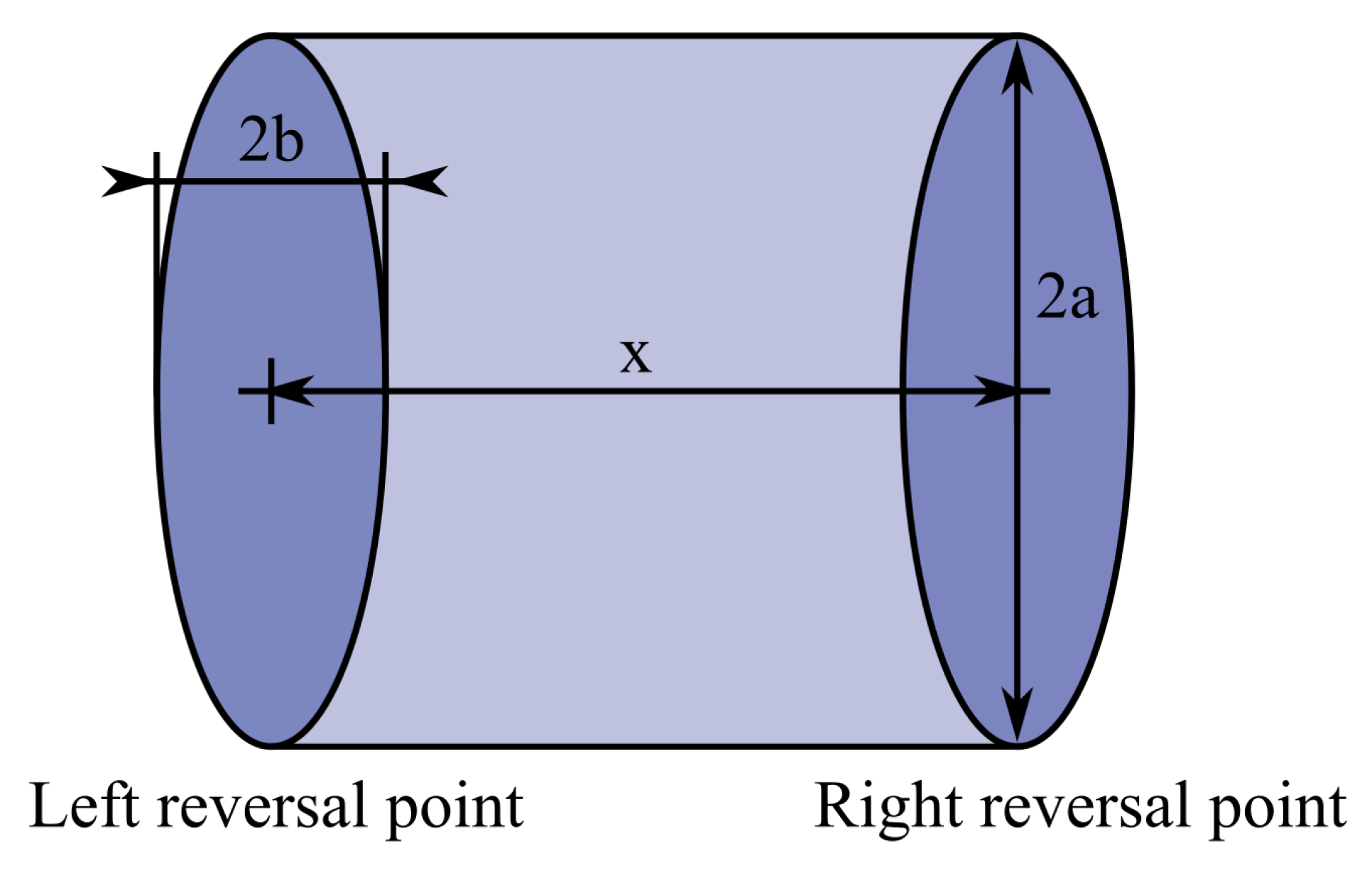

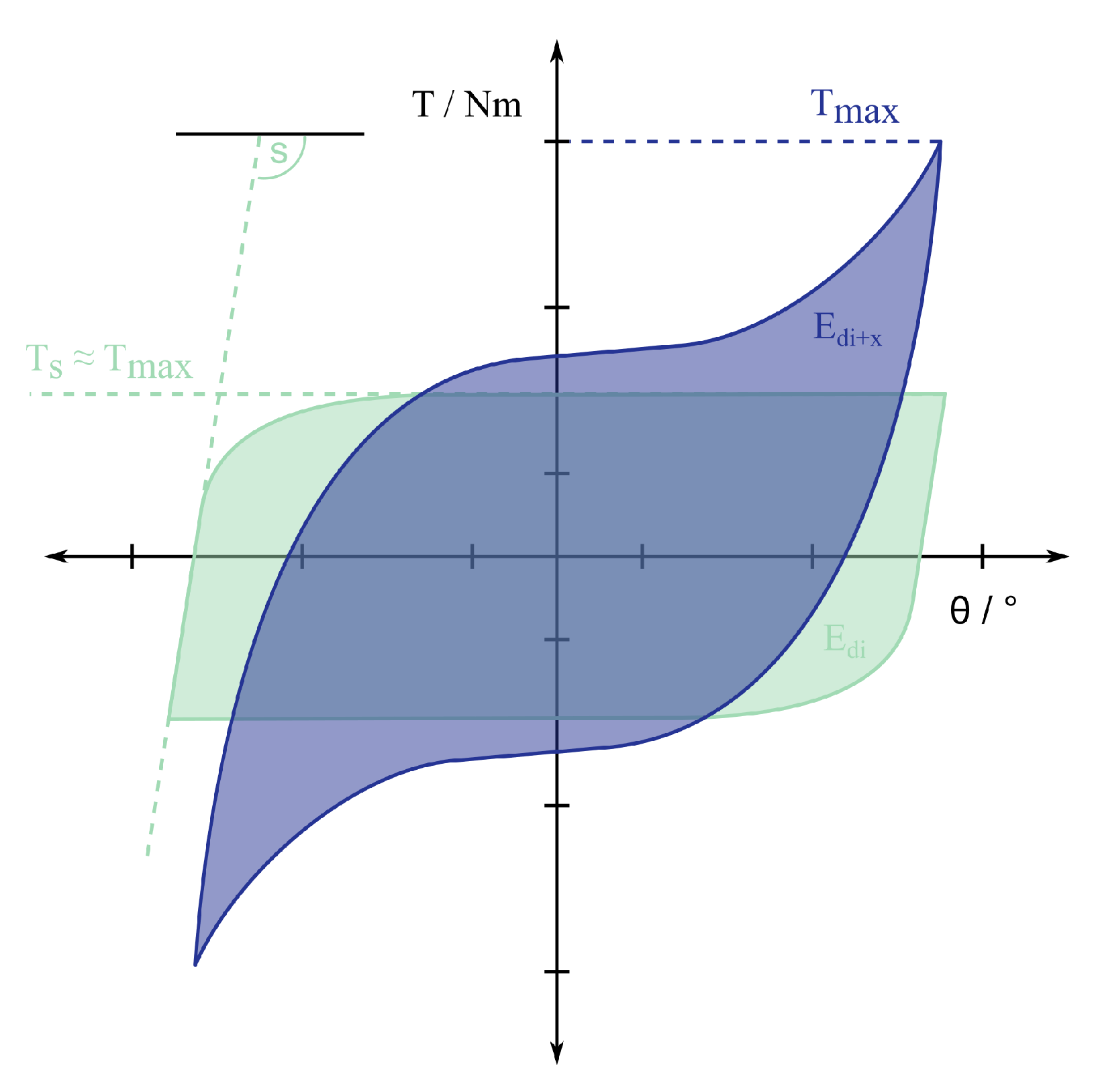
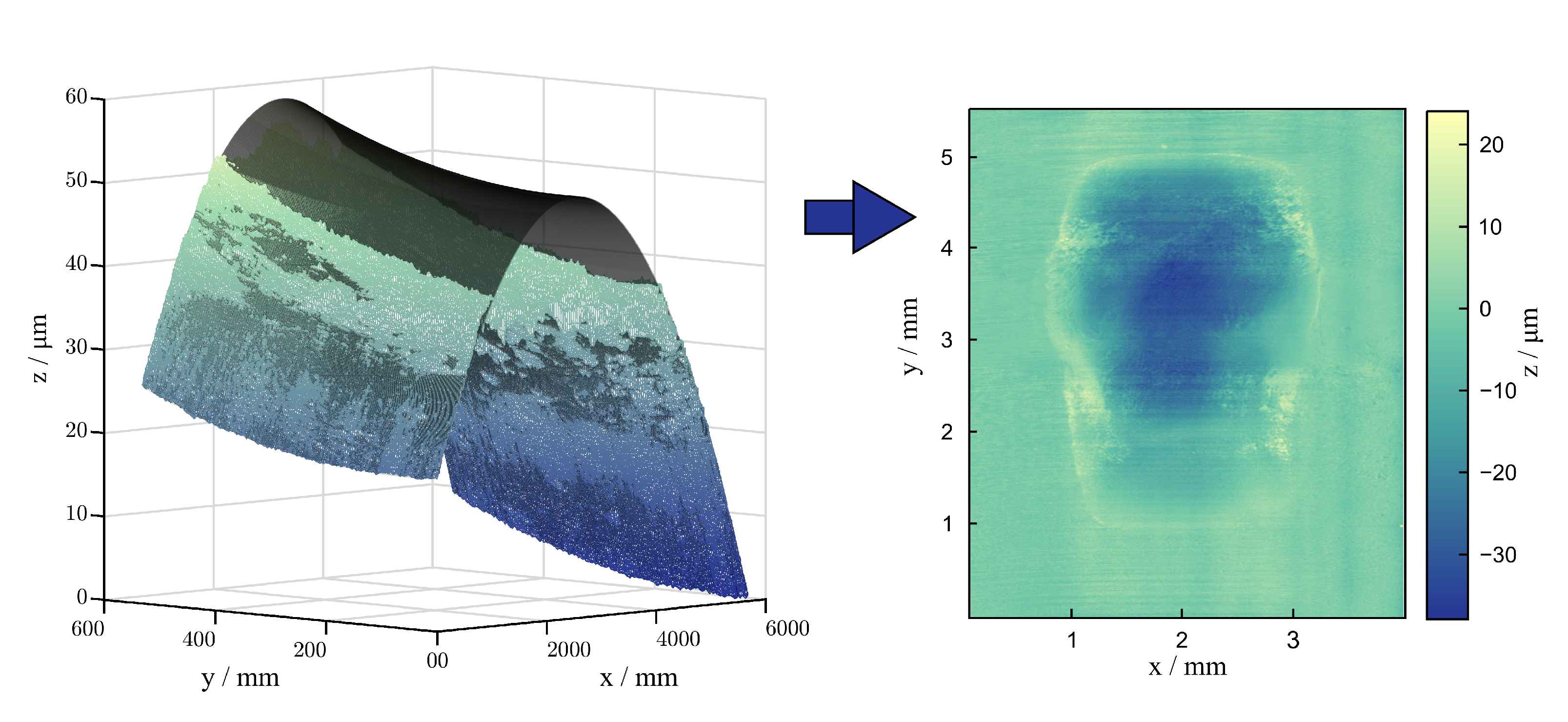

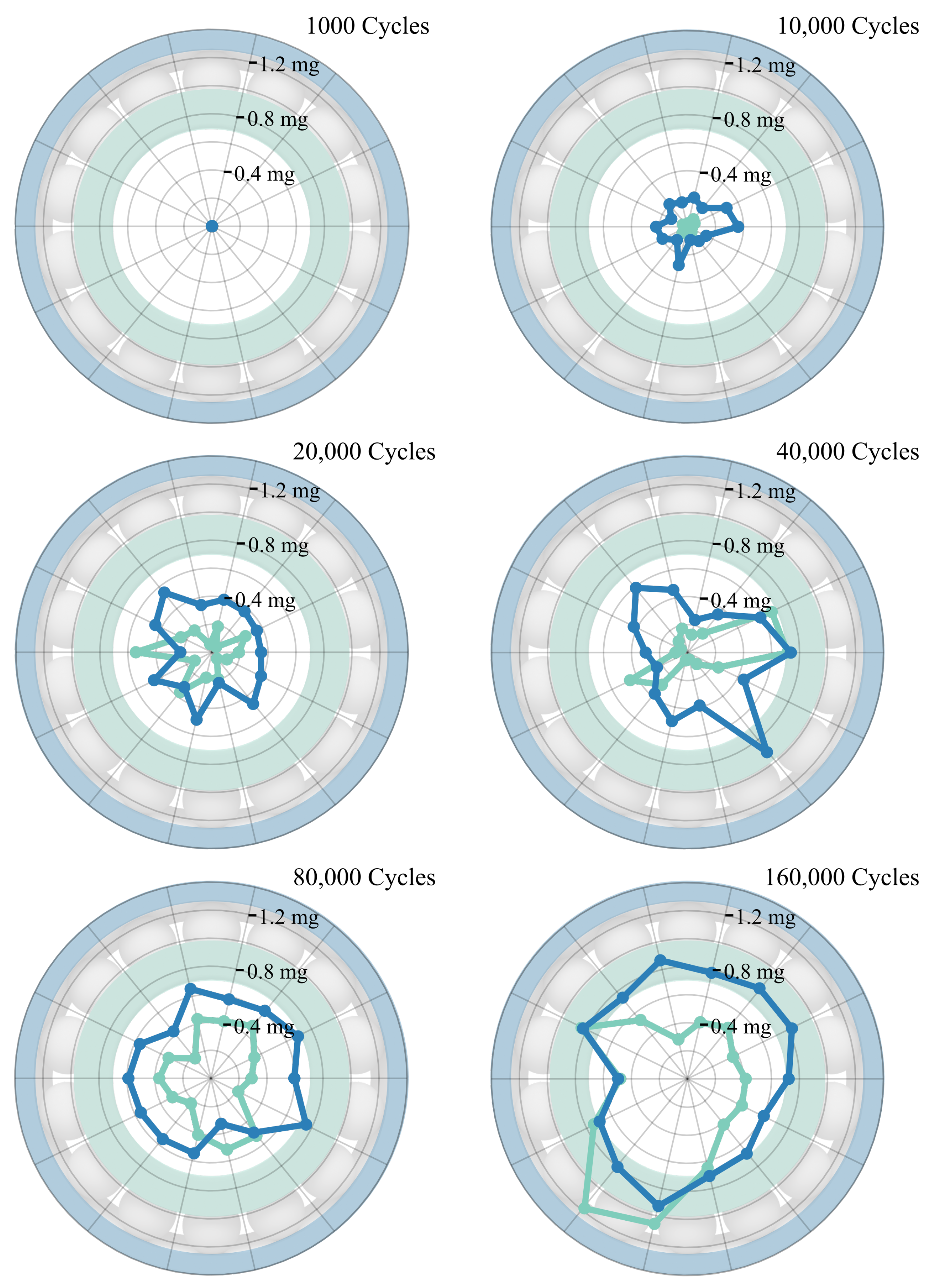

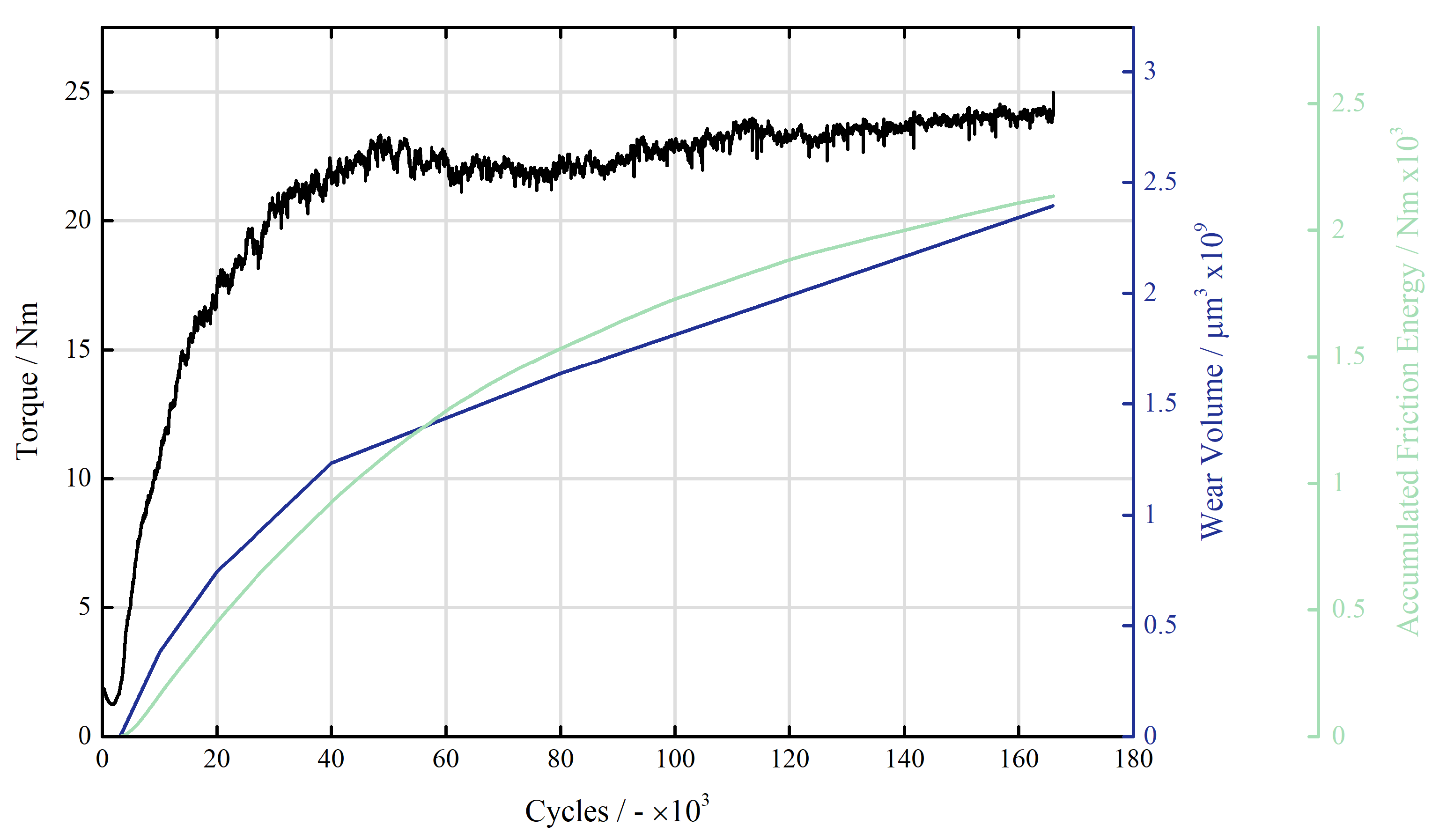
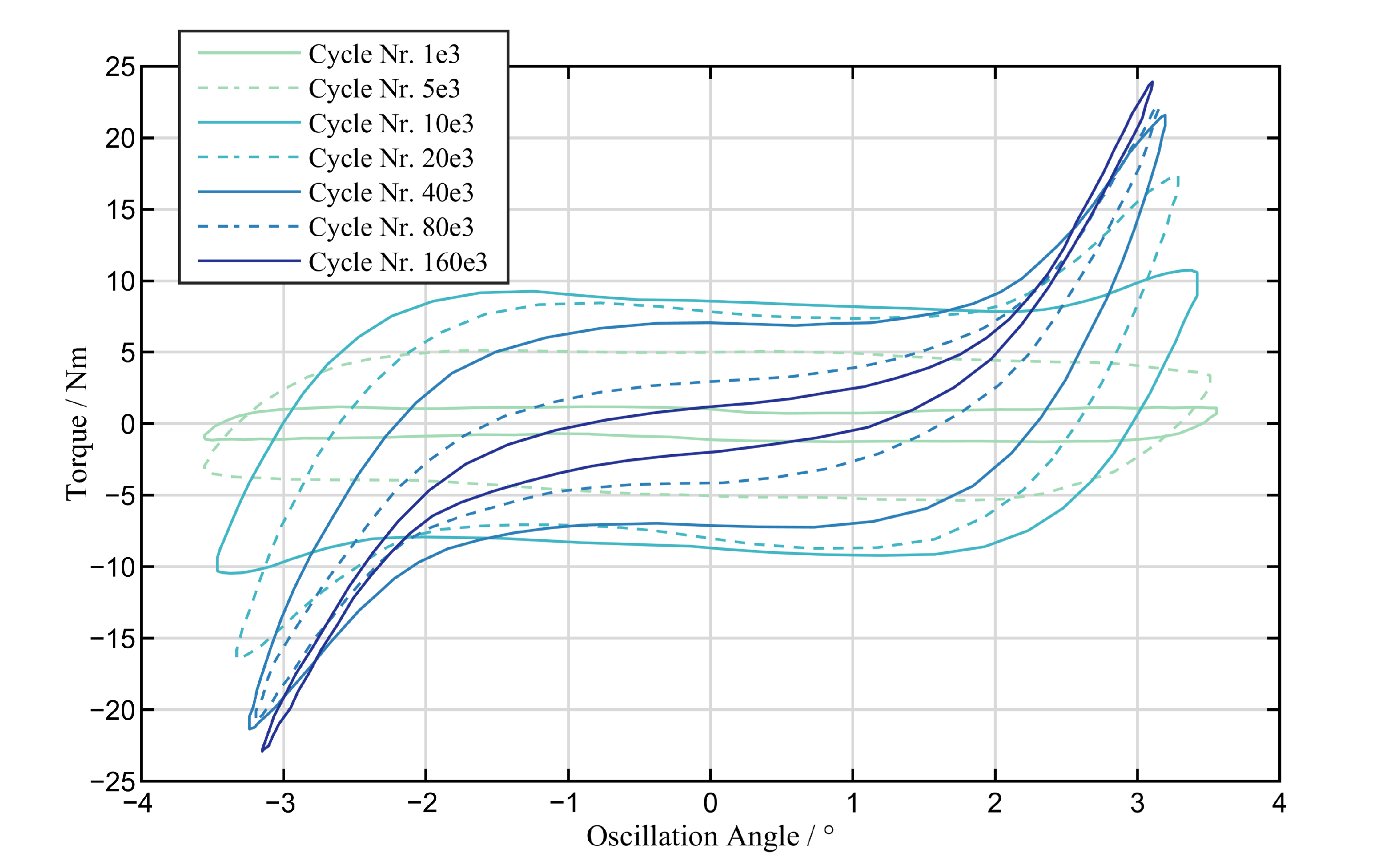
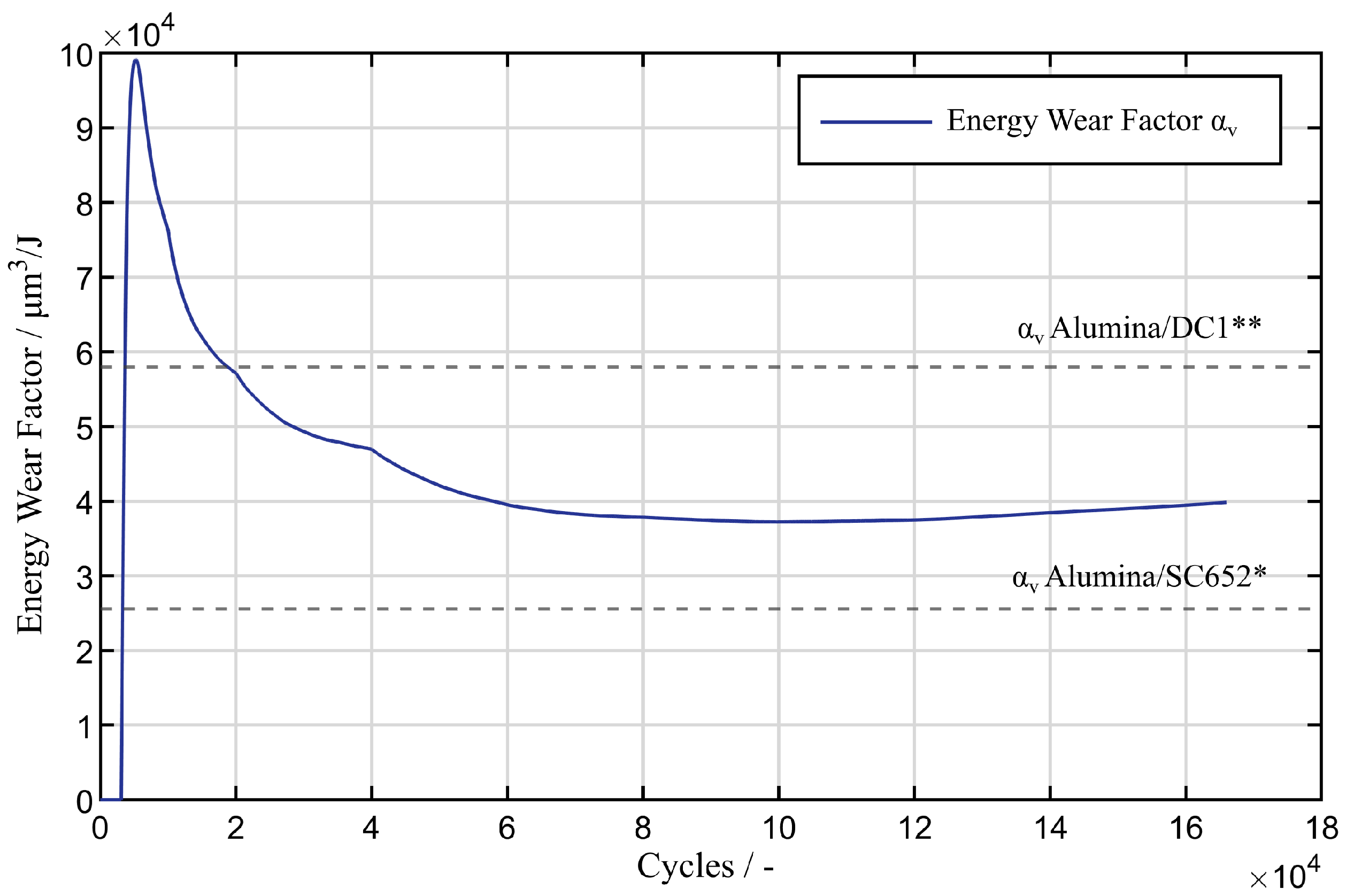

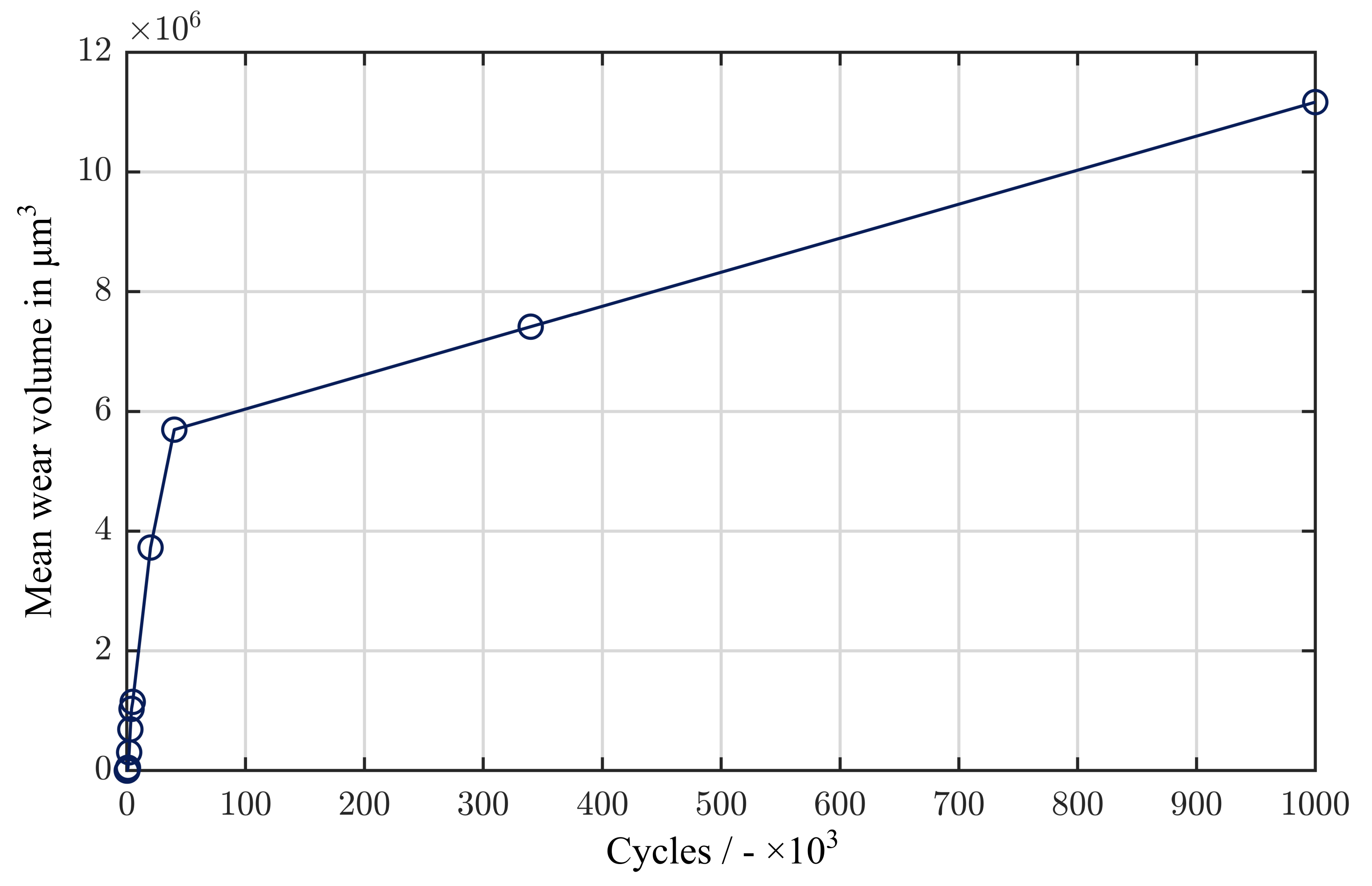
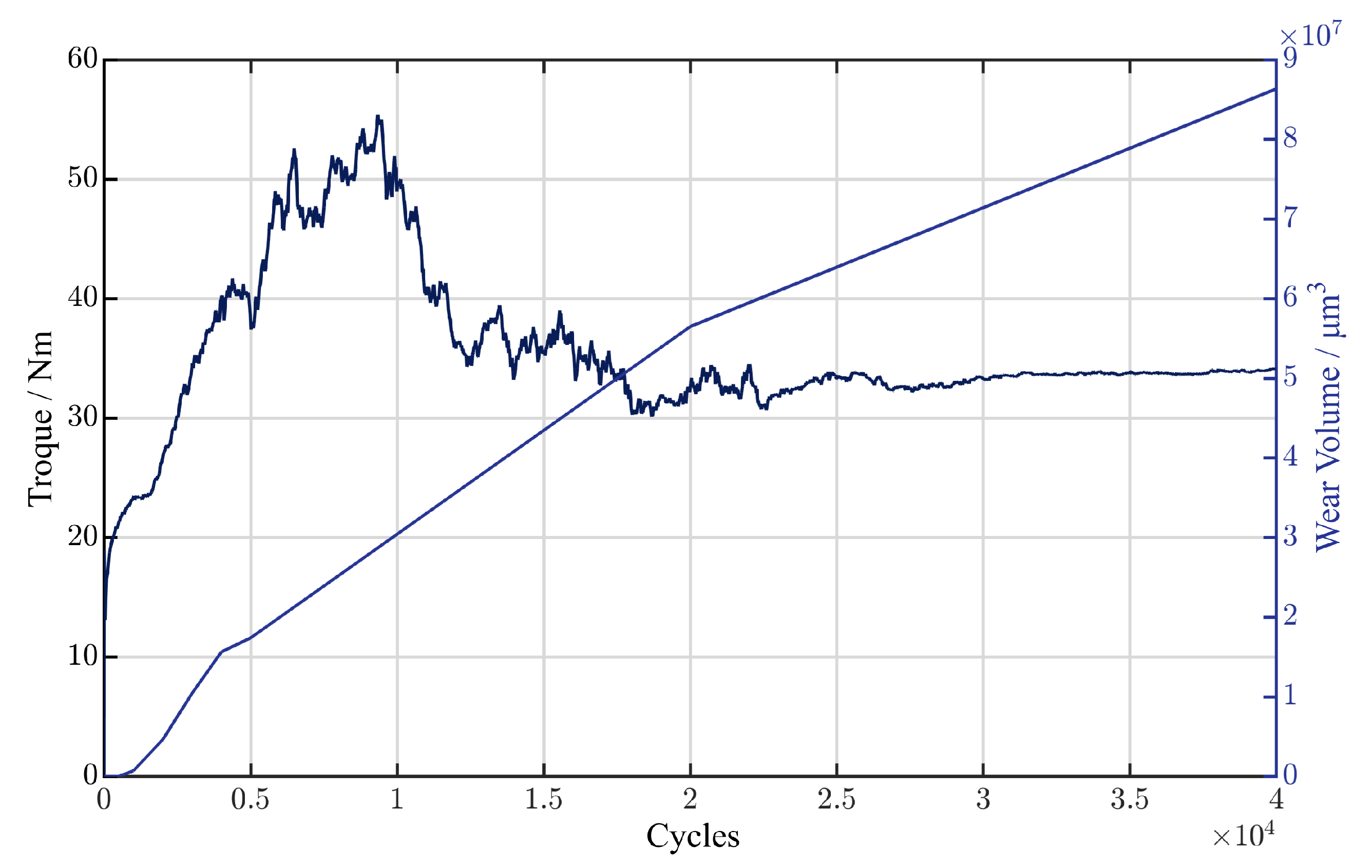
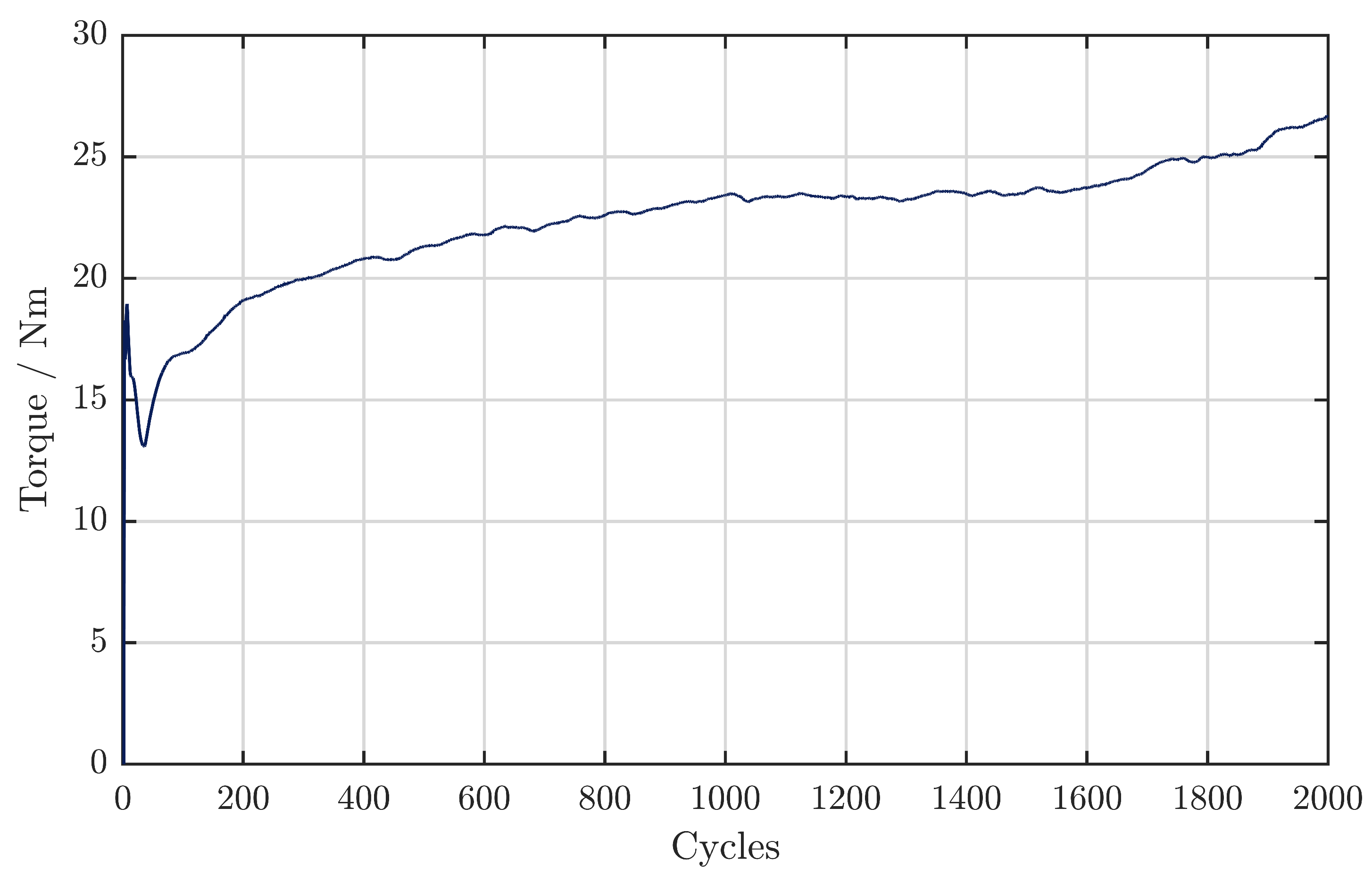
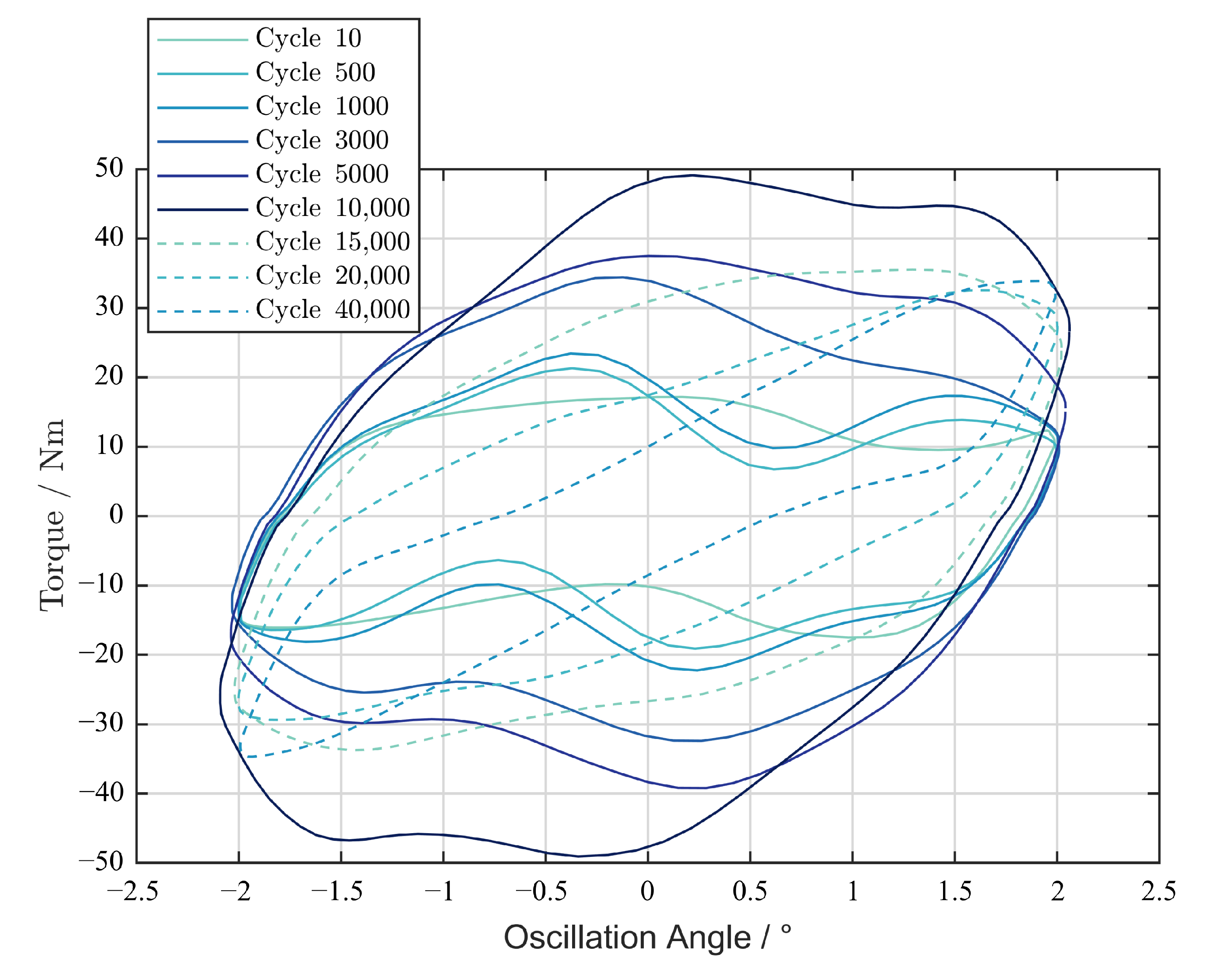
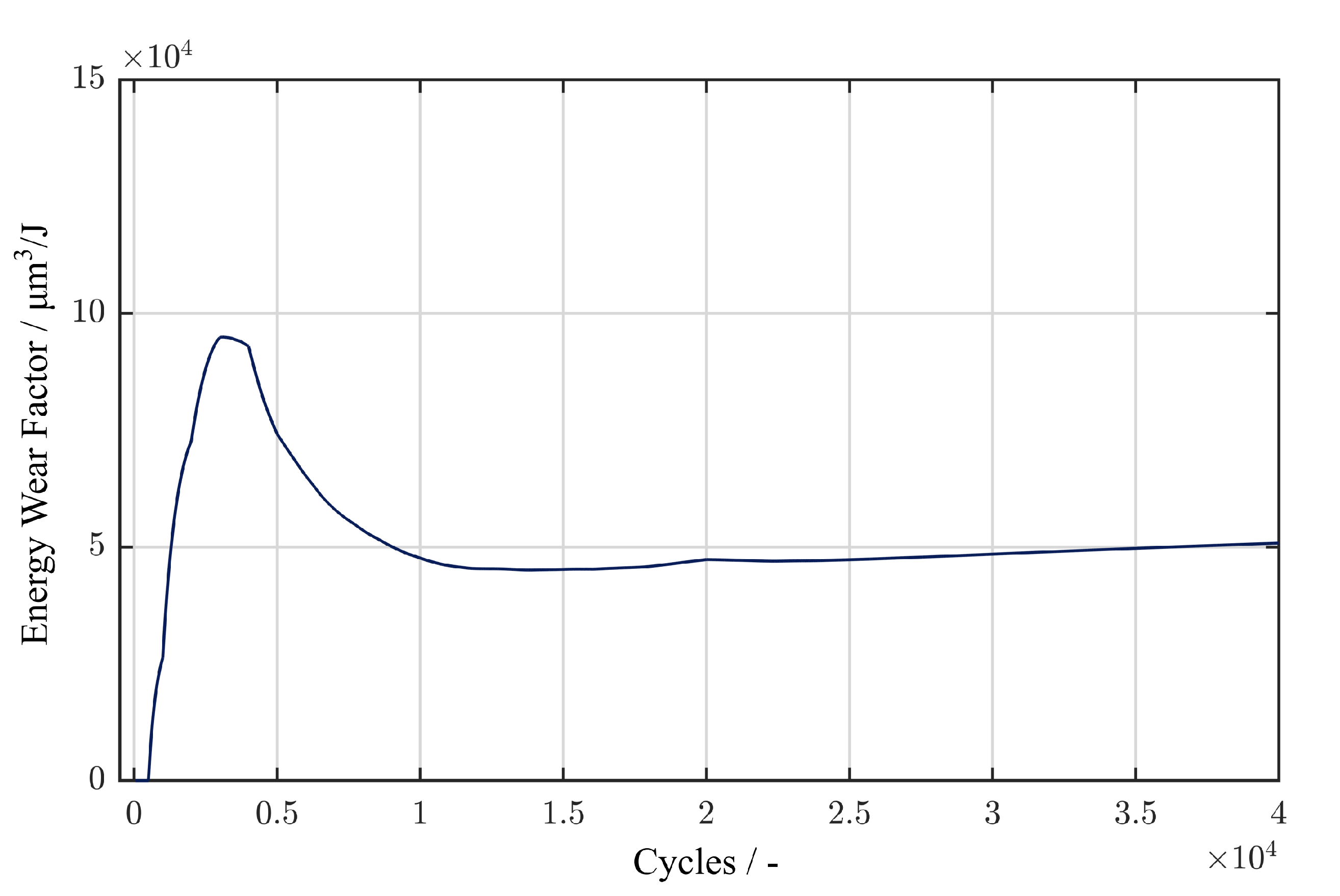

| Parameter | 7208 | 7220 | Unit |
|---|---|---|---|
| Type | Angular Contact Ball Bearing (ACBB) | ACBB | - |
| Inner Diameter d | 40 | 100 | mm |
| Outer Diameter D | 80 | 180 | mm |
| Diameter Rolling Element | 11.9 | 25.4 | mm |
| Number of Rolling Elements Z | 14 | 15 | - |
| Contact Angle | 40 | 40 | |
| Basic Dynamic Load Rating | 36,000 | 142,000 | N |
| Parameter | Grease 1 | Unit |
|---|---|---|
| Thickener Type | Lithium | - |
| Base Oil Type | Synthetic (PAO) | - |
| Base Oil Viscosity | 50 | cSt at 40 C |
| Oil Separation Rate (IP 121) | 4 | % |
| Dropping Point | >180 | C |
| Additives | Fully Additivated + Solid Lubricants | - |
| Parameter | 7208 | 7220 | Unit |
|---|---|---|---|
| Axial Load | 12.4 | 90 | kN |
| Contact Pressure | 2 | 2.5 | GPa |
| -Ratio | 5 | 2.8 | - |
| Oscillation Frequency f | 5 | 0.5 | Hz |
| Oscillation Angle | 7 | 4 | |
| Amplitude Ratio x/2b | 4 | 2.6 | - |
| Cycles | 1, 5, 10, 20, 40, 80, 160 | 0.5, 1, 2, 3, 4, 5, 20, 40, 340, 1000 | ×10 |
Disclaimer/Publisher’s Note: The statements, opinions and data contained in all publications are solely those of the individual author(s) and contributor(s) and not of MDPI and/or the editor(s). MDPI and/or the editor(s) disclaim responsibility for any injury to people or property resulting from any ideas, methods, instructions or products referred to in the content. |
© 2023 by the authors. Licensee MDPI, Basel, Switzerland. This article is an open access article distributed under the terms and conditions of the Creative Commons Attribution (CC BY) license (https://creativecommons.org/licenses/by/4.0/).
Share and Cite
Wandel, S.; Bartschat, A.; Glodowski, J.; Bader, N.; Poll, G. Wear Development in Oscillating Rolling Element Bearings. Lubricants 2023, 11, 117. https://doi.org/10.3390/lubricants11030117
Wandel S, Bartschat A, Glodowski J, Bader N, Poll G. Wear Development in Oscillating Rolling Element Bearings. Lubricants. 2023; 11(3):117. https://doi.org/10.3390/lubricants11030117
Chicago/Turabian StyleWandel, Sebastian, Arne Bartschat, Jakob Glodowski, Norbert Bader, and Gerhard Poll. 2023. "Wear Development in Oscillating Rolling Element Bearings" Lubricants 11, no. 3: 117. https://doi.org/10.3390/lubricants11030117
APA StyleWandel, S., Bartschat, A., Glodowski, J., Bader, N., & Poll, G. (2023). Wear Development in Oscillating Rolling Element Bearings. Lubricants, 11(3), 117. https://doi.org/10.3390/lubricants11030117






